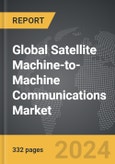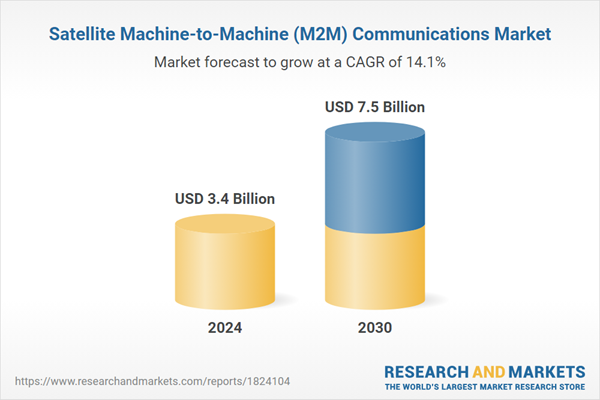Global Satellite Machine-to-Machine (M2M) Communications Market - Key Trends & Drivers Summarized
Satellite Machine-to-Machine (M2M) communications represent a critical component of the expanding Internet of Things (IoT) ecosystem, enabling seamless data exchange between remote machines and central management systems across vast distances. Unlike terrestrial M2M communication, which relies on cellular or Wi-Fi networks, satellite M2M leverages satellite connectivity to ensure reliable communication in areas where traditional infrastructure is unavailable or unreliable. This capability is particularly vital for industries such as maritime, oil and gas, agriculture, and environmental monitoring, where operations often occur in remote or harsh environments. Satellite M2M solutions include various components, such as satellite modems, antennas, and terminals, designed to transmit and receive data from remote sensors, vehicles, and equipment to central servers or cloud-based platforms for analysis and decision-making.Technological advancements have significantly enhanced the efficiency, reliability, and affordability of satellite M2M communications. The advent of low Earth orbit (LEO) satellite constellations has revolutionized the field by providing low-latency, high-bandwidth connectivity, making it feasible to support a broader range of applications and services. These advancements have reduced the cost and complexity of satellite communication equipment, enabling more widespread adoption across various industries. Furthermore, the integration of advanced data analytics and artificial intelligence (AI) has improved the ability to process and act on the data collected via satellite M2M networks. This integration facilitates real-time monitoring and predictive maintenance, optimizing operational efficiency and reducing downtime. The development of standardized communication protocols and interoperability frameworks has also enhanced the scalability and flexibility of satellite M2M solutions, allowing for seamless integration with existing IoT infrastructure.
The growth in the satellite M2M communications market is driven by several factors. Increasing demand for connectivity in remote and underserved regions is a primary driver, as industries seek reliable communication solutions to manage and monitor assets in isolated locations. The proliferation of IoT devices and the need for real-time data transmission for applications such as asset tracking, environmental monitoring and disaster response further fuel market growth. Technological advancements, particularly the deployment of LEO satellite constellations and improvements in satellite communication technology, are making satellite M2M more accessible and cost-effective. Additionally, regulatory support and the development of international standards for satellite communication are facilitating market expansion. The rise of smart agriculture, remote healthcare, and autonomous vehicles also presents new opportunities for satellite M2M applications. These factors, combined with ongoing innovation and investment in satellite technology, are expected to drive sustained growth in the satellite M2M communications market in the coming years.
Report Scope
The report analyzes the Satellite Machine-to-Machine (M2M) Communications market, presented in terms of market value (USD). The analysis covers the key segments and geographic regions outlined below.- Segments: Technology (Satellite Telemetry, Automatic Identification System (AIS), Very Small Aperture Terminal (VSAT); End-Use (Transportation & Logistics, Maritime, Aerospace & Defense, Security & Surveillance, Automotive, Oil & Gas, Other End-Uses).
- Geographic Regions/Countries: World; USA; Canada; Japan; China; Europe; France; Germany; Italy; UK; Rest of Europe; Asia-Pacific; Rest of World.
Key Insights:
- Market Growth: Understand the significant growth trajectory of the Satellite Telemetry Technology segment, which is expected to reach US$2.8 Billion by 2030 with a CAGR of 13.7%. The Automatic Identification System (AIS) Technology segment is also set to grow at 13.1% CAGR over the analysis period.
- Regional Analysis: Gain insights into the U.S. market, valued at $1.2 Billion in 2024, and China, forecasted to grow at an impressive 16.8% CAGR to reach $995.9 Million by 2030. Discover growth trends in other key regions, including Japan, Canada, Germany, and the Asia-Pacific.
Why You Should Buy This Report:
- Detailed Market Analysis: Access a thorough analysis of the Global Satellite Machine-to-Machine (M2M) Communications Market, covering all major geographic regions and market segments.
- Competitive Insights: Get an overview of the competitive landscape, including the market presence of major players across different geographies.
- Future Trends and Drivers: Understand the key trends and drivers shaping the future of the Global Satellite Machine-to-Machine (M2M) Communications Market.
- Actionable Insights: Benefit from actionable insights that can help you identify new revenue opportunities and make strategic business decisions.
Key Questions Answered:
- How is the Global Satellite Machine-to-Machine (M2M) Communications Market expected to evolve by 2030?
- What are the main drivers and restraints affecting the market?
- Which market segments will grow the most over the forecast period?
- How will market shares for different regions and segments change by 2030?
- Who are the leading players in the market, and what are their prospects?
Report Features:
- Comprehensive Market Data: Independent analysis of annual sales and market forecasts in US$ Million from 2024 to 2030.
- In-Depth Regional Analysis: Detailed insights into key markets, including the U.S., China, Japan, Canada, Europe, Asia-Pacific, Latin America, Middle East, and Africa.
- Company Profiles: Coverage of players such as Honeywell International, Inc., General Electric Company, Singapore Telecommunications Ltd. (SingTel), Sierra Wireless, Inc., Israel Aerospace Industries Ltd. and more.
- Complimentary Updates: Receive free report updates for one year to keep you informed of the latest market developments.
Some of the 45 companies featured in this Satellite Machine-to-Machine (M2M) Communications market report include:
- Honeywell International, Inc.
- General Electric Company
- Singapore Telecommunications Ltd. (SingTel)
- Sierra Wireless, Inc.
- Israel Aerospace Industries Ltd.
- Telenor ASA
- ORBCOMM
- Telit IoT Platforms, LLC
- Leonardo SpA
- SkyBitz, Inc.
- Applied Satellite Technology Systems Ltd.
- Quake Global, Inc.
- Telenor Satellite
- Prodigium Group Ltd.
- mu Space and Advanced Technology Co., Ltd.
This edition integrates the latest global trade and economic shifts into comprehensive market analysis. Key updates include:
- Tariff and Trade Impact: Insights into global tariff negotiations across 180+ countries, with analysis of supply chain turbulence, sourcing disruptions, and geographic realignment. Special focus on 2025 as a pivotal year for trade tensions, including updated perspectives on the Trump-era tariffs.
- Adjusted Forecasts and Analytics: Revised global and regional market forecasts through 2030, incorporating tariff effects, economic uncertainty, and structural changes in globalization. Includes historical analysis from 2015 to 2023.
- Strategic Market Dynamics: Evaluation of revised market prospects, regional outlooks, and key economic indicators such as population and urbanization trends.
- Innovation & Technology Trends: Latest developments in product and process innovation, emerging technologies, and key industry drivers shaping the competitive landscape.
- Competitive Intelligence: Updated global market share estimates for 2025, competitive positioning of major players (Strong/Active/Niche/Trivial), and refined focus on leading global brands and core players.
- Expert Insight & Commentary: Strategic analysis from economists, trade experts, and domain specialists to contextualize market shifts and identify emerging opportunities.
Table of Contents
Companies Mentioned (Partial List)
A selection of companies mentioned in this report includes, but is not limited to:
- Honeywell International, Inc.
- General Electric Company
- Singapore Telecommunications Ltd. (SingTel)
- Sierra Wireless, Inc.
- Israel Aerospace Industries Ltd.
- Telenor ASA
- ORBCOMM
- Telit IoT Platforms, LLC
- Leonardo SpA
- SkyBitz, Inc.
- Applied Satellite Technology Systems Ltd.
- Quake Global, Inc.
- Telenor Satellite
- Prodigium Group Ltd.
- mu Space and Advanced Technology Co., Ltd.
Table Information
| Report Attribute | Details |
|---|---|
| No. of Pages | 332 |
| Published | December 2025 |
| Forecast Period | 2024 - 2030 |
| Estimated Market Value ( USD | $ 3.4 Billion |
| Forecasted Market Value ( USD | $ 7.5 Billion |
| Compound Annual Growth Rate | 14.1% |
| Regions Covered | Global |









